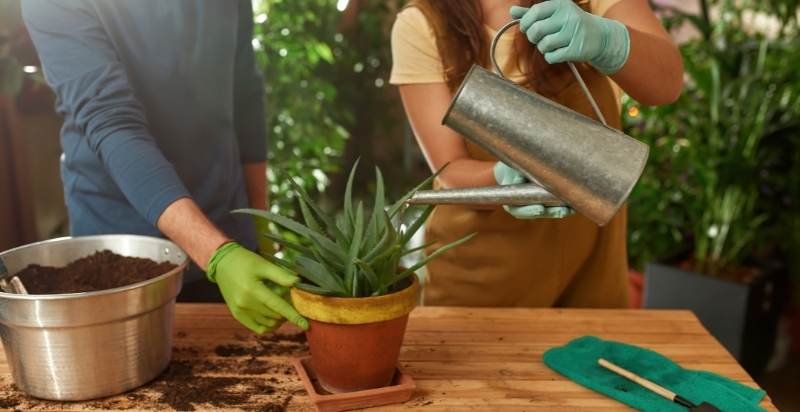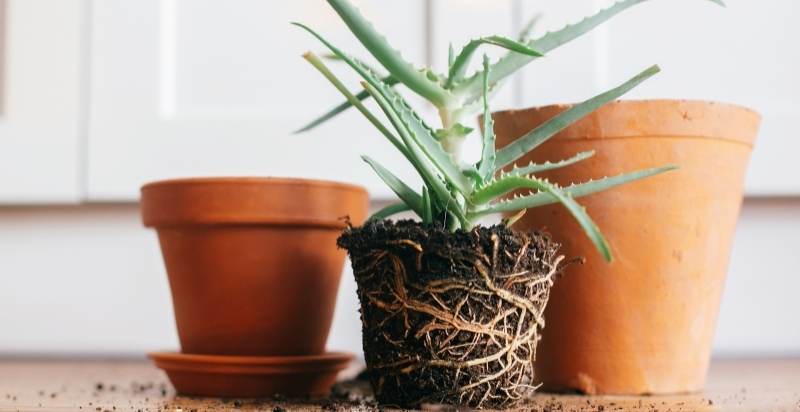Have you ever had that sinking feeling when you walk into your kitchen or bathroom and see your aloe plant turning brown? Maybe the leaves look a little wilted, or the stem is yellowing. Regardless of what caused it, it’s never a fun sight.
Aloe plants are succulents, which means they store water in their leaves, making them very resilient to drought conditions. However, if they are overwatered, the leaves will start to turn brown and rot. If you notice your aloe plant turning brown, there are a few things you can do to try and save it.
In this article, we’ll go over why aloe plants turn brown, how to prevent it from happening, and what to do if your plant is already showing signs of browning.
Reasons For Aloe Plant Turning Brown
A few reasons could cause your aloe plant to start turning brown. The most common reason is overwatering. When succulents are overwatered, the leaves can start to rot, and this is because the saturated leaves cannot store or process moisture properly. The leaves will turn yellow or brown and eventually fall off the plant.
Other causes of aloe plants turning brown include: Some of the most common include:
- Too much sun exposure
- Not enough water
- Overwatering
- Pests or diseases
- Temperature changes
1. Too Much Sun Exposure
One of the most common reasons an Aloe plant turns brown is too much sun exposure. Aloes are native to Africa and thrive in sunny, dry conditions. However, they can also be harmed by too much sun.
If you live in an area with sweltering summers, it’s crucial to provide your Aloe plant with some protection from the intense heat and direct sunlight. One way to do this is to place it in a spot with filtered sunlight or dappled shade. You can also try moving it indoors during the year’s hottest months.
2. Not Enough Water
Another common reason for an Aloe plant turning brown is not enough water. Aloes need regular watering, especially during the hot summer months. However, they don’t like to sit in wet soil, so be sure to use a well-draining potting mix and only water when the soil is dry to the touch. If you think your Aloe plant isn’t getting enough water, try giving it a good soak once a week.
3. Overwatering
While not watering your Aloe plant enough can cause browning of the leaves, overwatering can also be a problem. If you suspect you are overwatering your Aloe plant, check the drainage holes at the bottom of the pot to ensure they are not blocked. Water your plant only when the top inch or so of soil is dry to the touch.

4. Pests or Diseases
Pests and diseases can also cause an Aloe plant to turn brown. Common pests that attack Aloe plants include mealybugs, whiteflies, and spider mites. These pests can suck the moisture out of the leaves, causing them to turn brown and wither away. If you suspect your Aloe plant has pests, check the undersides of the leaves for small, white insects. You can also look for webbing or honeydew (a sticky substance left behind by aphids).
If your Aloe plant is infected with a disease, it’s important to act quickly to save the plant. Some common diseases that affect Aloes include root rot and powdery mildew. These diseases can spread quickly, so it’s important to isolate any affected plants and destroy any infected leaves.
5. Temperature Changes
Another common cause of an Aloe plant turning brown is temperature changes. Aloes are native to Africa, where the temperatures are relatively stable. However, in other parts of the world, the temperature can fluctuate greatly from season to season.
If your Aloe plant is exposed to these temperature changes, it can cause the leaves to turn brown and wilt. To protect your plant from temperature fluctuations, try placing it in a spot that is out of direct sunlight and away from drafts or heat sources.
How To Prevent Aloe Plants from Turning Brown
The best way to prevent your aloe plant from turning brown is to water it properly. Aloe plants are very drought-tolerant, so they don’t need a lot of water. Overwatering is the most common reason for aloe plants to turn brown.
To water your aloe plant, wait until the soil is dry before watering it again. It’s best to water the plant in the morning, so the leaves have time to dry before nightfall. During the winter, you can reduce watering to once every two weeks.
In addition to watering, there are a few other things you can do to prevent your aloe plant from turning brown:
Fertilize: Fertilizing your aloe plant will help it stay healthy and prevent the leaves from turning brown. However, it’s important to use a balanced fertilizer low in nitrogen, and Fertilizing too often or using too much fertilizer can burn the leaves.
Prune: Pruning your aloe plant will help it stay healthy and prevent the leaves from turning brown. When pruning, make sure to cut off any dead or dying leaves. You should also cut back on any leggy growth.
Repotting : Repotting your aloe plant will help it stay healthy and prevent the leaves from turning brown. When repotting, use a well-draining potting mix and a pot slightly larger than the current one.

What To Do If Aloe Plant Is Already Turning Brown
If your aloe plant is already turning brown, there are a few things you can do to save it. The most important thing is to figure out what’s causing the problem so you can address it.
Once you’ve figured out the cause, please take the appropriate action to fix it. For example, if overwatering is the problem, water your plant less often. If pests are the problem, use a pesticide or try home remedies like soapy water or rubbing alcohol.
If the leaves of your aloe plant are already brown and dying, you can try to remove them, which will help the plant focus its energy on new growth. To remove the leaves, cut them off at the base with a sharp knife.
Finally, if your aloe plant is severely damaged, you can try propagating it. This will allow you to start a new plant from a healthy piece of the old one. To propagate an aloe plant, cut off a healthy leaf and allow it to callus for a few days. Once the leaf is callused, you can pot it up in some well-draining potting mix. With proper care, your new plant should grow in a few weeks.
Aloe plants are tough and resilient, so don’t give up hope if yours is turning brown. With a little care, you can return it to health in no time.
Conclusion
Aloe plants are susceptible to problems that can cause them to turn brown. The most common problem is overwatering, which can lead to root rot. Other problems include pests, disease, and lack of sunlight.
The best way to prevent your aloe plant from turning brown is to water it properly and give it enough sunlight. If your plant is already turning brown, you can try to save it by figuring out the cause and taking the appropriate action. With a little care, you can bring your aloe plant back to health in no time.
- Everything You Wanted to Know About Red Tamarillos - June 2, 2025
- A Guide to Tulips: Everything You Need to Know & More… - June 2, 2025
- Guanabana: Description, Flavor, Benefits, And Uses - May 27, 2025
